An Innovative Approach for Gob-Side Entry Retaining in Thick Coal Seam Longwall Mining
Abstract
:1. Introduction
2. An Innovative Approach for Gob-Side Entry Retaining
2.1. Principle of the Fracturing Roofs to Maintain Entry (FRME) Approach
2.2. Mechanical Model
2.3. Key Techniques of the FRME Approach
2.3.1. Directional Roof Fracturing Technique
2.3.2. Constant Resistance and Large Deformation Anchor (CRLDA) Cable Support Technique
3. Laws of the Roof Structure and Stresses
3.1. Structure Characteristics of Surrounding Rocks
3.2. Stress Evolution during the FRME Processes
3.2.1. Geological Details
3.2.2. Global Model
3.2.3. Simulation Plans and Results
4. Fracturing Roofs to Maintain Entry (FRME) Design
4.1. Roof Fracturing Design
4.2. Entry Support Design
4.2.1. Entry-in Support
4.2.2. Entry-Side Support
5. Field Test and Monitoring
5.1. Construction of Key Techniques
- (i)
- Drill blasting holes. The hole diameter and depth were 46 mm and 9139 mm, respectively. To reduce dynamic effects from gob roof caving, the drilling direction of each hole should be consistent.
- (ii)
- Conduct blasting tests. Because there are always errors in theoretical calculations, site tests were essential to obtain the optimal charging parameters. First, we experimented with single hole blasting to determine the base charge and rational stemming length. Subsequently, double nonadjacent hole blasting was conducted to determine a rational charge amount and hole distance. The blasting effects were evaluated by the degree of crack propagation for the middle hole as obtained by borehole imaging. If the crack growth rate did not meet the specification (90%), an adjacent hole blasting experiment was performed to obtain the optimal blasting parameters. The ultimate blasting in the S1201 headentry adopted an air-space charge with borehole spacing of 600 mm and a charge structure with a “3 + 3 + 3 + 3 + 2” pattern, as shown in Figure 16.
- (iii)
- Perform roof fracturing. On the basis of the predefined blasting parameters, energy-accumulated devices filled with emulsified blasting powder were installed in the holes. It is noteworthy that the energy-accumulated grooves must point in the same direction, as shown in Figure 15d. After blasting, the cracks formed a whole roof fracturing line at the roof surface (see Figure 15e). The unfolded inner surface images of the blasting holes illustrate that the energy-gathered effect of the directional roof fracturing technique was effective, as shown in Figure 15f.
- (i)
- Drilling and chambering. Before drilling, the cable locations should be marked based on the design. The drilling hole diameters were 28 mm, and the drilling direction was vertical to the entry roof. After drilling, a chambering drill bit with diameter of 75 mm was used to enlarge the holes. The chambering depth was 500 mm.
- (ii)
- Install stranded steel rope and anchoring resin. The anchoring resins were first transported to the anchored end through a PVC air duct hose. The resins were used to fix the top of the steel rope on the stable roof rock. The stranded steel rope was then pushed to the hole end and used to stir the anchoring resins for approximately 20 to 30 s, as shown in Figure 17b. After the resin has been solidified, the accessories of the CRLDA cable were finally installed.
- (iii)
- Install the accessories (see Figure 17c). In this step, a W-type steel band, a constant resistance device, a cable plate, and a cable lock were fixed in turn on the stranded steel rope.
- (iv)
5.2. Field Monitoring
5.2.1. Pressure Characteristics
5.2.2. Deformation Behavior
5.3. Entry Retaining Effects
6. Conclusions
Acknowledgments
Author Contributions
Conflicts of Interest
References
- Milici, R.C.; Flores, R.M.; Stricker, G.D. Coal resources, reserves and peak coal production in the United States. Int. J. Coal Geol. 2013, 113, 109–115. [Google Scholar] [CrossRef]
- Lechner, A.M.; Kassulke, O.; Unger, C. Spatial assessment of open cut coal mining progressive rehabilitation to support the monitoring of rehabilitation liabilities. Resour. Policy 2016, 50, 234–243. [Google Scholar] [CrossRef]
- Islavath, S.R.; Deb, D.; Kumar, H. Numerical analysis of a longwall mining cycle and development of a composite longwall index. Int. J. Rock Mech. Min. Sci. 2016, 89, 43–54. [Google Scholar] [CrossRef]
- He, M.C.; Zhu, G.L.; Guo, Z.B. Longwall mining “cutting cantilever beam theory” and 110 mining method in China-The third mining science innovation. J. Rock Mech. Geotech. Eng. 2015, 7, 483–492. [Google Scholar] [CrossRef]
- Suchowerska, A.M.; Merifield, R.S.; Carter, J.P. Vertical stress changes in multi-seam mining under supercritical longwall panels. Int. J. Rock Mech. Min. Sci. 2013, 61, 306–320. [Google Scholar] [CrossRef]
- Rezaei, M.; Hossaini, M.F.; Majdi, A. Development of a time-dependent energy model to calculate the mining-induced stress over gates and pillars. J. Rock Mech. Geotech. Eng. 2015, 7, 306–317. [Google Scholar] [CrossRef]
- Wang, S.L.; Hao, S.P.; Chen, Y.; Bai, J.B.; Wang, X.Y.; Xu, Y. Numerical investigation of coal pillar failure under simultaneous static and dynamic loading. Int. J. Rock Mech. Min. Sci. 2016, 84, 59–68. [Google Scholar]
- Zhang, N.; Yuan, L.; Han, C.L.; Xue, J.H.; Kan, J.G. Stability and deformation of surrounding rock in pillarless gob-side entry retaining. Saf. Sci. 2012, 50, 593–597. [Google Scholar] [CrossRef]
- Yang, H.Y.; Cao, S.G.; Wang, S.Q.; Fan, Y.C.; Wang, S.; Chen, X.Z. Adaptation assessment of gob-side entry retaining based on geological factors. Eng. Geol. 2016, 209, 143–151. [Google Scholar] [CrossRef]
- Li, X.H.; Ju, M.H.; Yao, Q.L.; Zhou, J.; Chong, Z.H. Numerical investigation of the effect of the location of critical rock block fracture on crack evolution in a gob-side filling wall. Rock Mech. Rock Eng. 2016, 49, 1041–1058. [Google Scholar] [CrossRef]
- Zhou, B.J.; Xu, J.H.; Zhao, M.S.; Zeng, Q.L. Stability study on naturally filling body in gob-side entry retaining. Int. J. Min. Sci. Technol. 2012, 22, 423–427. [Google Scholar] [CrossRef]
- Jiang, H.Q.; Miao, X.X.; Zhang, J.X.; Liu, S.W. Gateside packwall design in solid backfill mining–A case study. Int. J. Min. Sci. Technol. 2016, 26, 261–265. [Google Scholar] [CrossRef]
- Deng, Y.H.; Tang, J.X.; Zhu, X.K.; Fu, Y.; Dai, Z.L. Analysis and application in controlling surrounding rock of support reinforced roadway in gob-side entry with fully mechanized. Int. J. Min. Sci. Technol. 2010, 6, 841–845. [Google Scholar] [CrossRef]
- Tan, Y.L.; Yu, F.H.; Ning, J.G.; Zhao, T.B. Design and construction of entry retaining wall along a gob side under hard roof stratum. Int. J. Rock Mech. Min. Sci. 2015, 77, 115–121. [Google Scholar] [CrossRef]
- Zhang, Z.Z.; Bai, J.B.; Chen, Y.; Yan, S. An innovative approach for gob-side entry retaining in highly gassy fully-mechanized longwall top-coal caving. Int. J. Rock Mech. Min. Sci. 2015, 80, 1–11. [Google Scholar] [CrossRef]
- Yang, H.Y.; Cao, S.G.; Li, Y.; Sun, C.M.; Guo, P. Soft roof failure mechanism and supporting method for gob-side entry retaining. Minerals 2015, 5, 707–722. [Google Scholar] [CrossRef]
- Kang, H.P.; Wu, Y.Z.; Gao, F.Q. Deformation characteristics and reinforcement technology for entry subjected to mining-induced stresses. J. Rock Mech. Geotech. Eng. 2011, 3, 207–219. [Google Scholar] [CrossRef]
- Chen, Y.; Bai, J.B.; Yan, S.; Xu, Y.; Wang, X.Y.; Ma, S.Q. Control mechanism and technique of floor heave with reinforcing solid coal side and floor corner in gob-side coal entry retaining. Int. J. Min. Sci. Technol. 2012, 22, 841–845. [Google Scholar] [CrossRef]
- Gao, Y.B.; Guo, Z.B.; Yang, J.; Wang, J.W.; Wang, Y.J. Steady analysis of gob-side entry retaining formed by roof fracturing and control techniques by optimizing mine pressure. J. China Coal Soc. 2017, 42, 1672–1681. [Google Scholar]
- Hua, X.Z. Development status and improved proposals on gob-side entry retaining support technology in China. Coal Sci. Technol. 2006, 34, 78–81. [Google Scholar]
- Fei, X.M. The status of support technology on gob-side entry retaining roadway and existing problem discussion. Chin. Sci. Technol. Inf. 2008, 7, 48–49. [Google Scholar]
- Westergaard, H.M. Theory of Elasticity and Plasticity, 1st ed.; Harvard University Press: Cambridge, UK, 1953; pp. 105–163. [Google Scholar]
- Peng, S.S.; Chiange, H.S. Longwall Mining, 1st ed.; Wiley: New York, NY, USA, 1984; pp. 121–155. [Google Scholar]
- He, M.C.; Wang, J.; Sun, X.M.; Yang, X.J. Mechanics characteristics and applications of prevention and control rock bursts of the negative poisson’s ratio effect anchor. J. China Coal Soc. 2014, 39, 214–221. [Google Scholar]
- He, M.C.; Gong, W.L.; Wang, J.; Qi, P.; Tao, Z.G.; Du, S.; Peng, Y.Y. Development of a novel energy–absorbing bolt with extraordinarily large elongation and constant resistance. Int. J. Rock Mech. Min. Sci. 2014, 67, 29–42. [Google Scholar] [CrossRef]
- Su, C.D.; Gu, M.; Tang, X.; Guo, W.B. Experiment study of compaction characteristics of crushed stones from coal seam roof. Chin. J. Rock Mech. Eng. 2012, 31, 18–26. [Google Scholar]
- He, M.C.; Li, C.; Gong, W.L.; Wang, J.; Tao, Z.G. Support principles of NPR bolts/cables and control techniques of large deformation. Chin. J. Rock Mech. Eng. 2016, 35, 1513–1529. [Google Scholar]
- Qian, M.G.; Shi, P.W.; Xu, J.L. Mine Pressure and Strata Control, 1st ed.; China Mining University Press: Xuzhou, China, 2010; pp. 71–73. [Google Scholar]
- Palchik, V. Bulking factors and extents of caved zones in weathered overburden of shallow abandoned underground workings. Int. J. Rock Mech. Min. Sci. 2015, 79, 227–240. [Google Scholar] [CrossRef]
- Yavuz, H. An estimation method for cover pressure re-establishment distance and pressure distribution in the goaf of longwall coal mines. Int. J. Rock Mech. Min. Sci. 2004, 41, 193–205. [Google Scholar] [CrossRef]

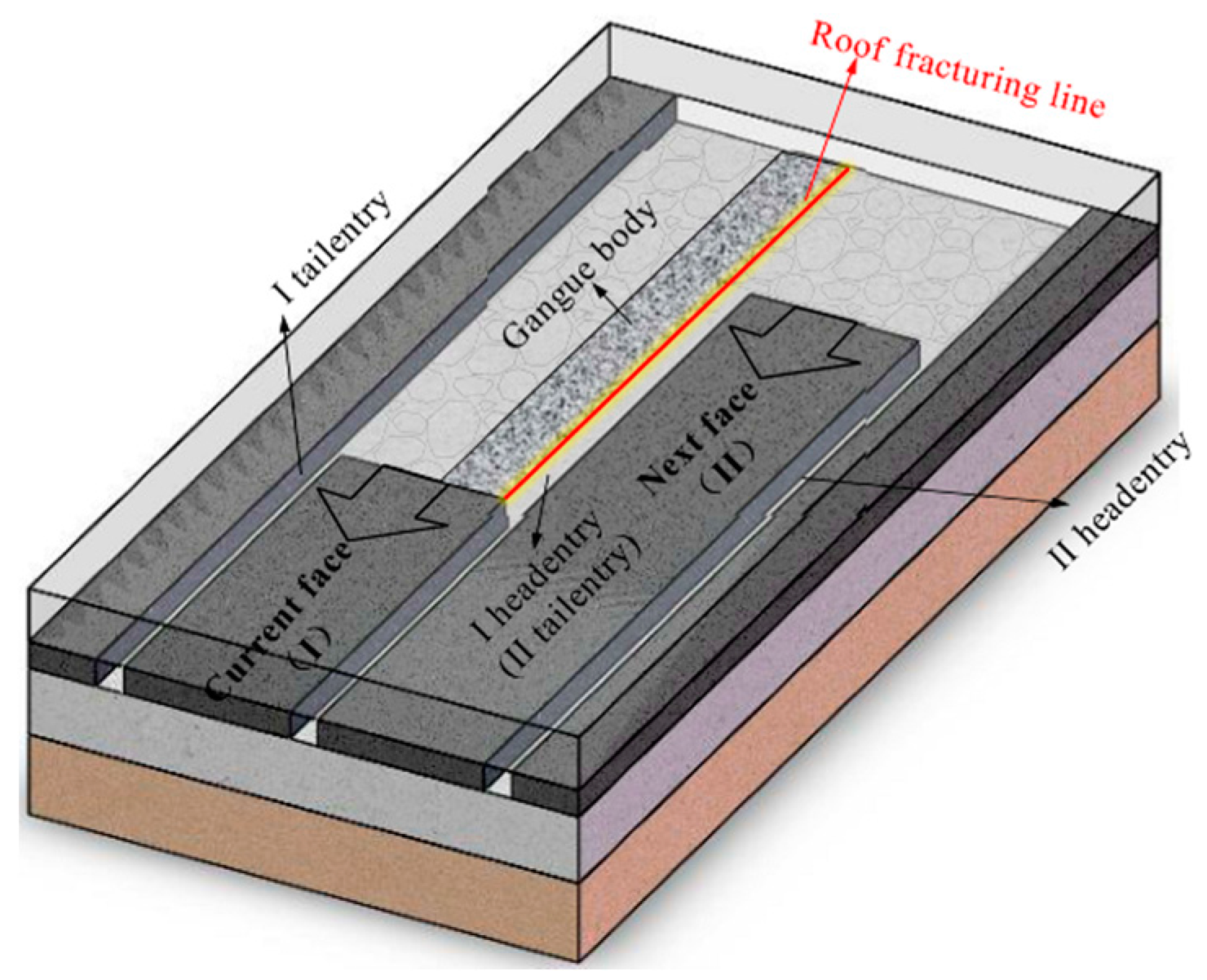



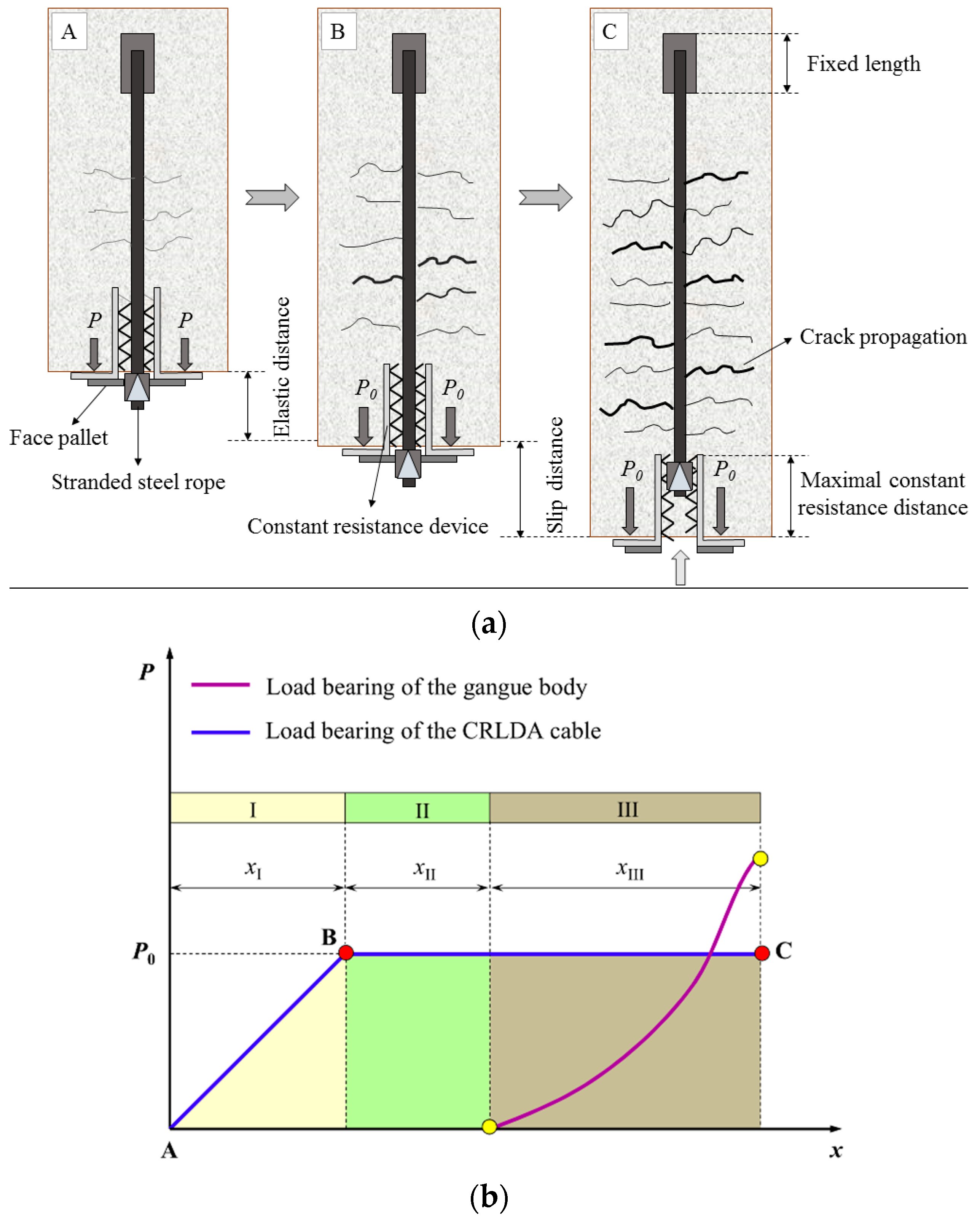
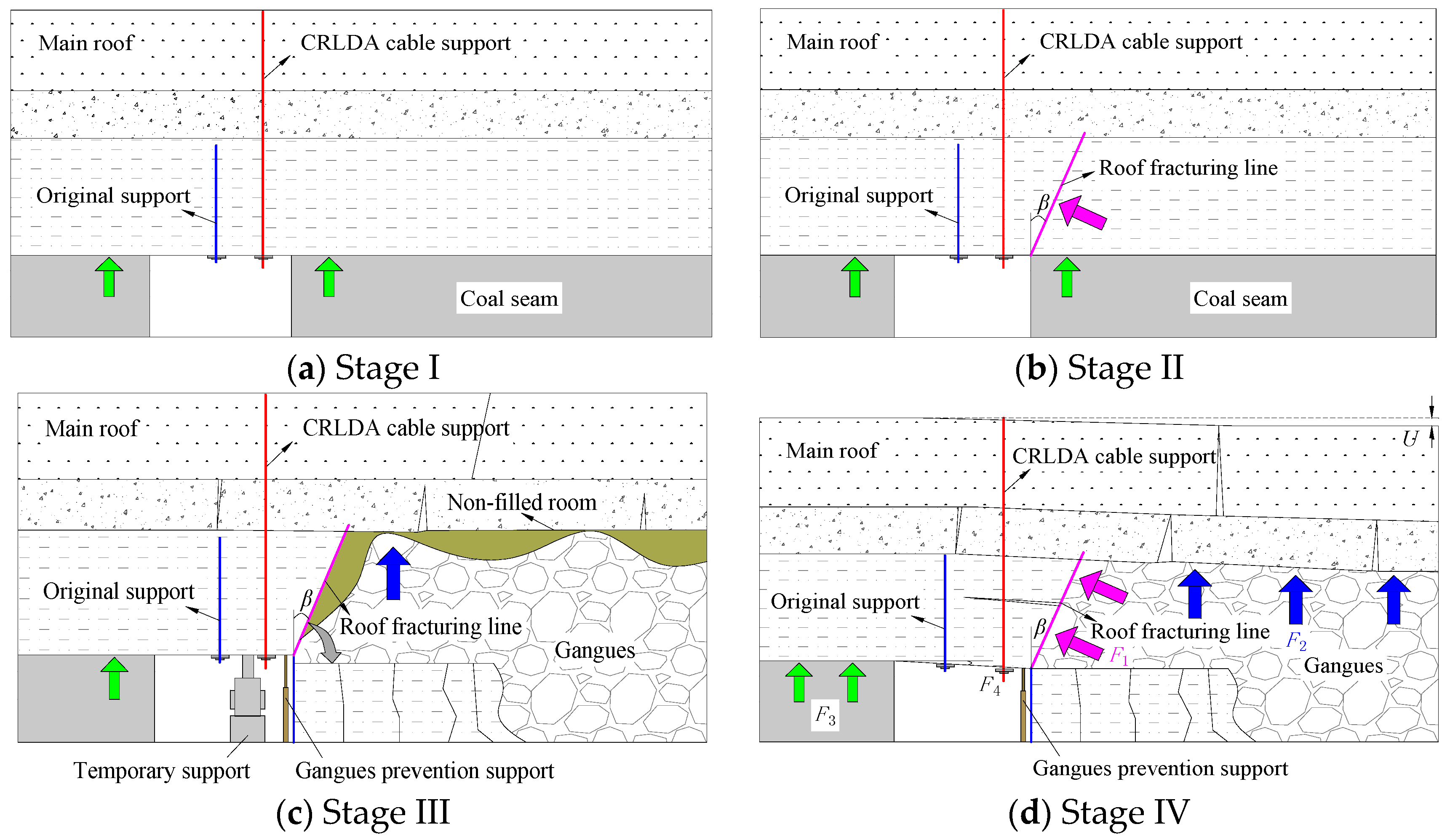

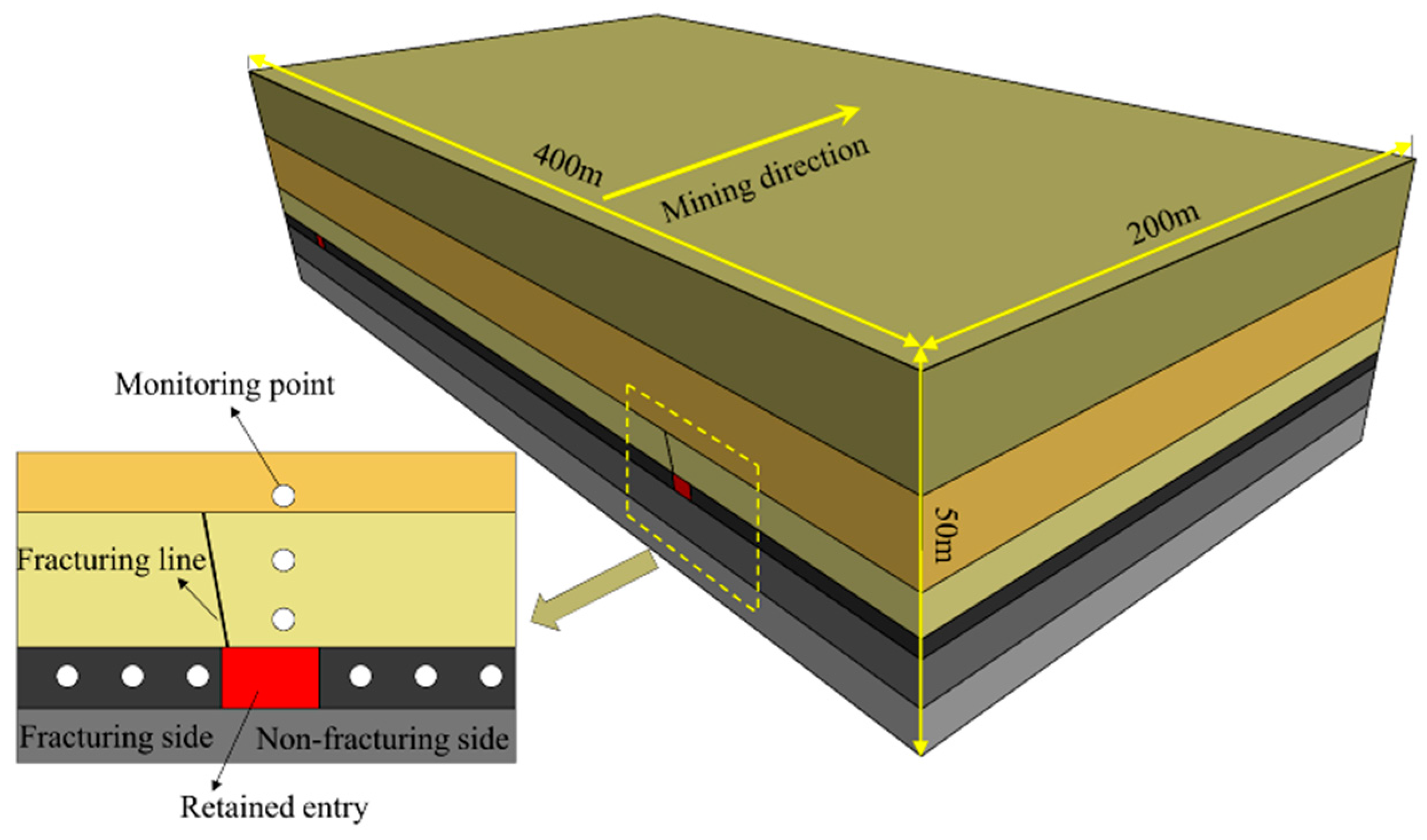

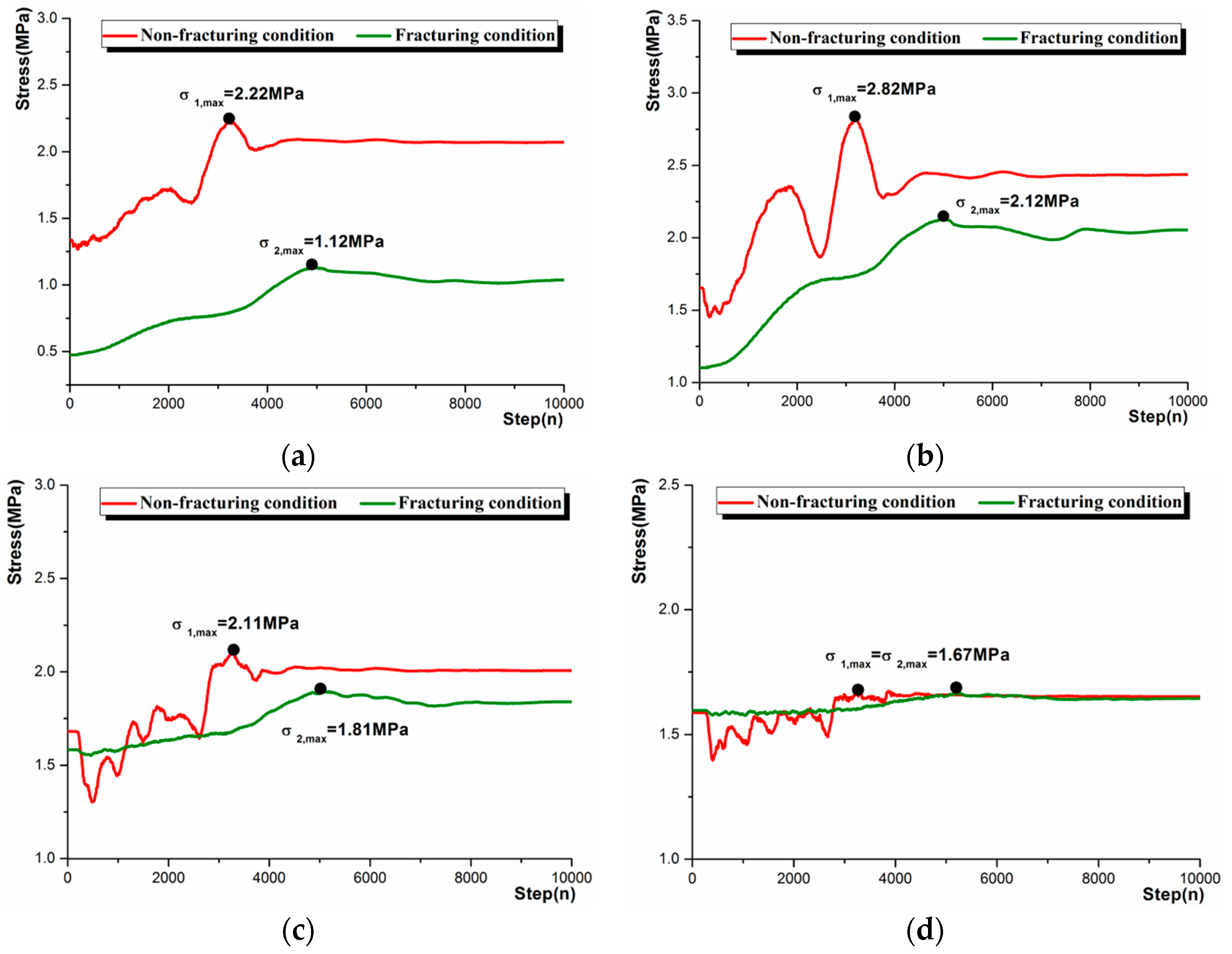


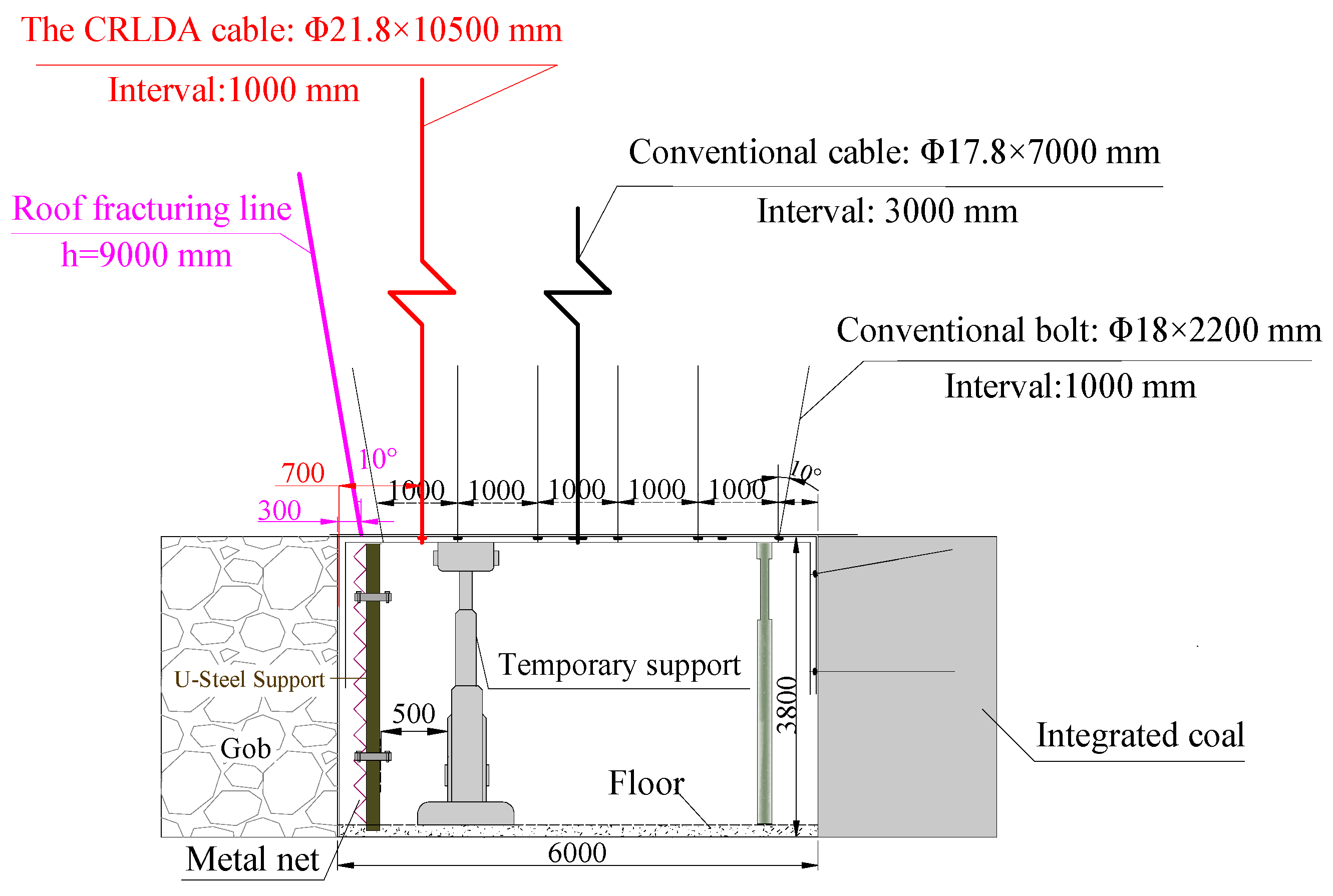

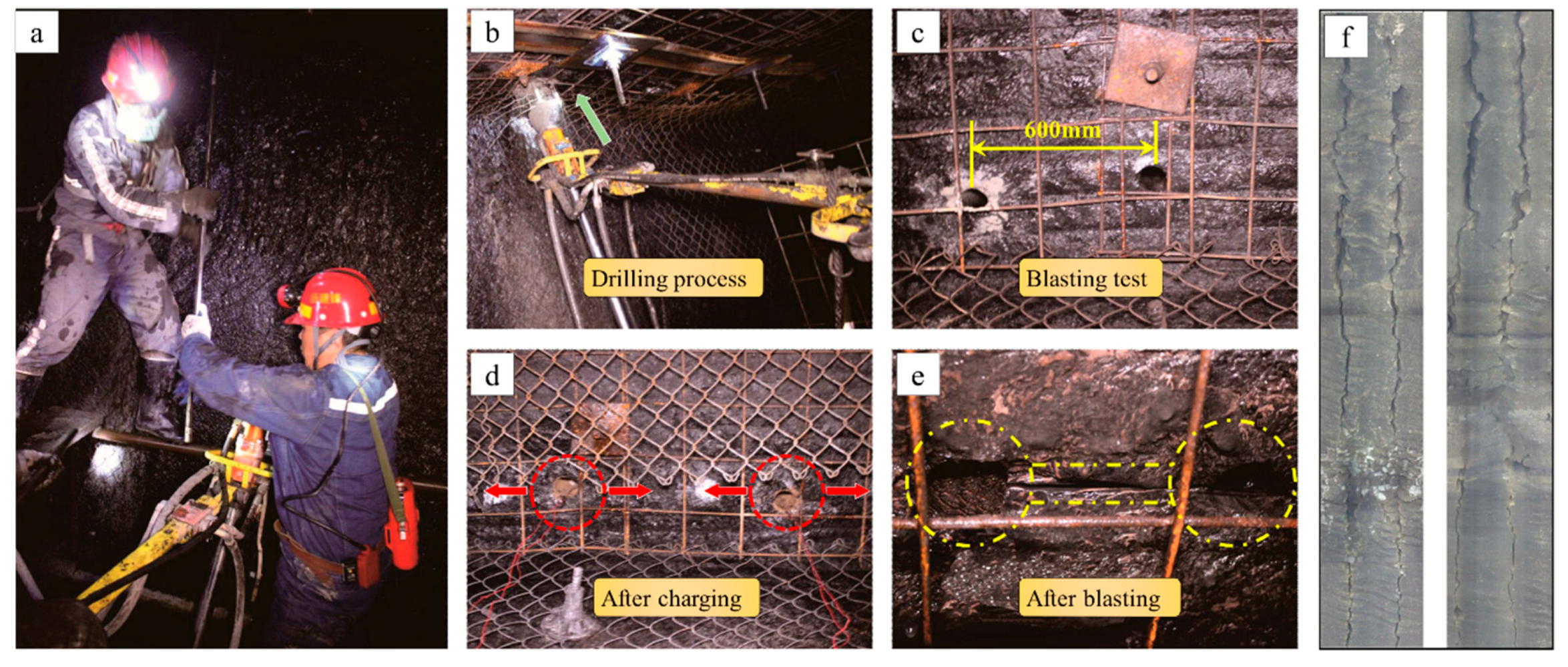
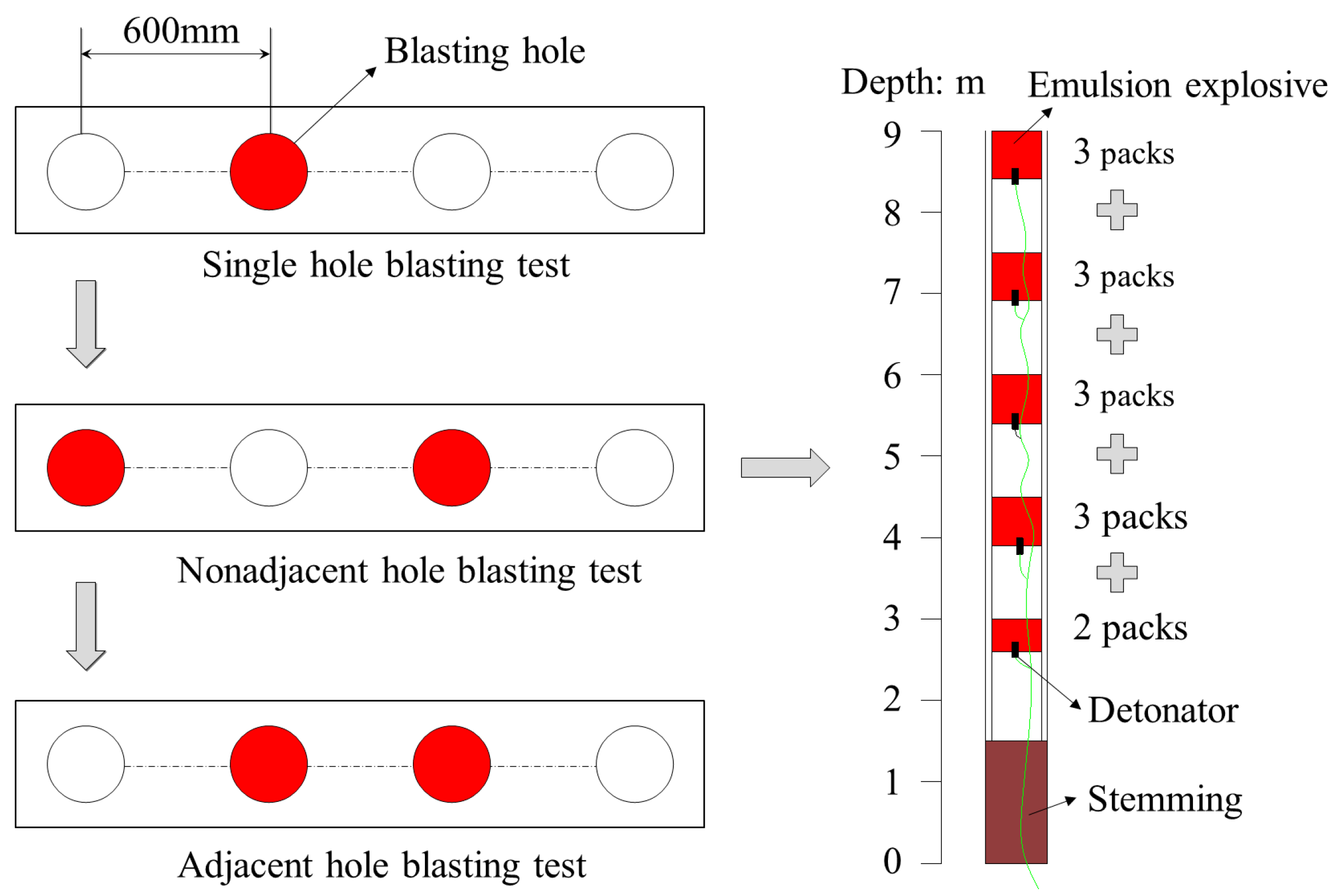

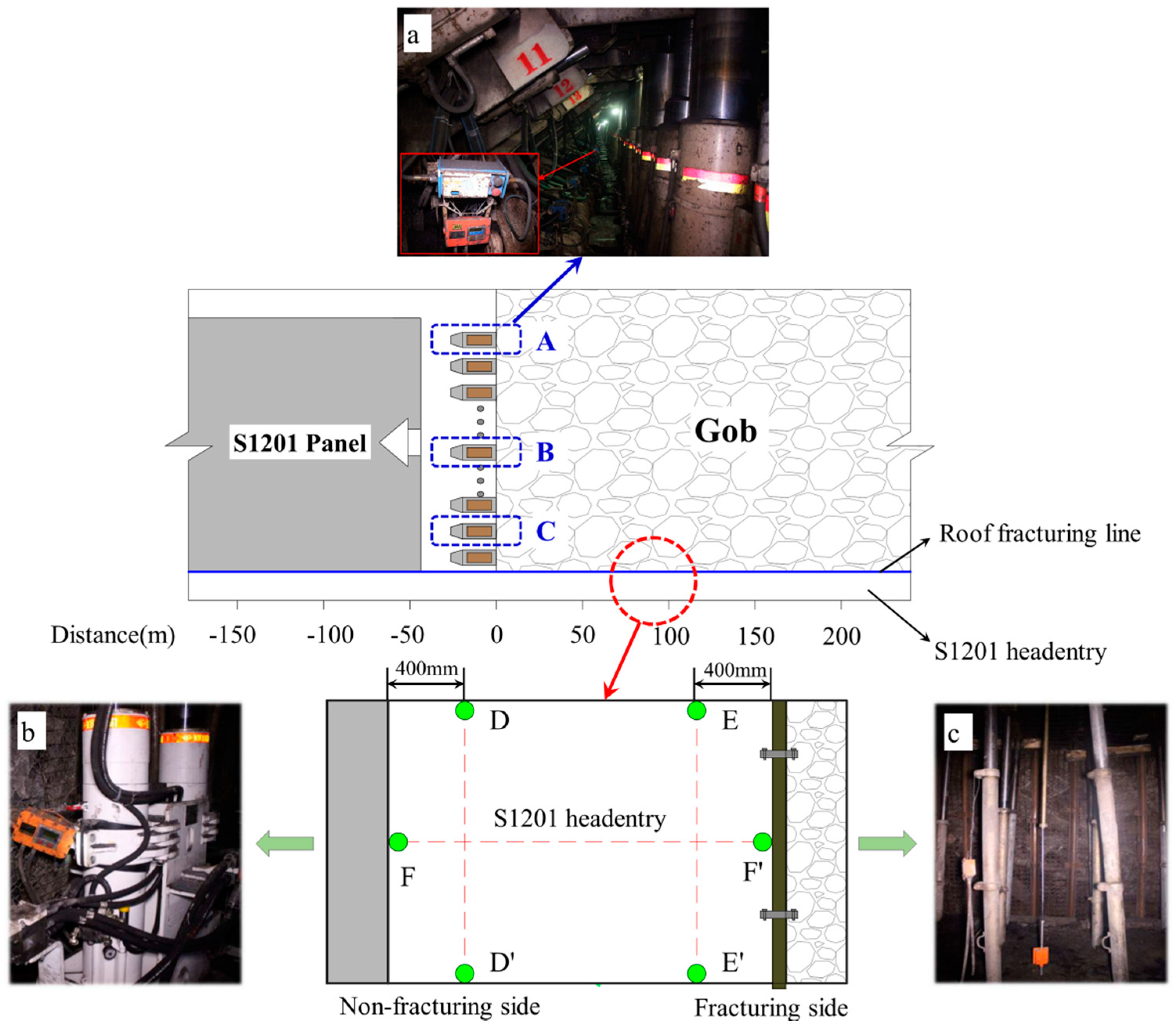
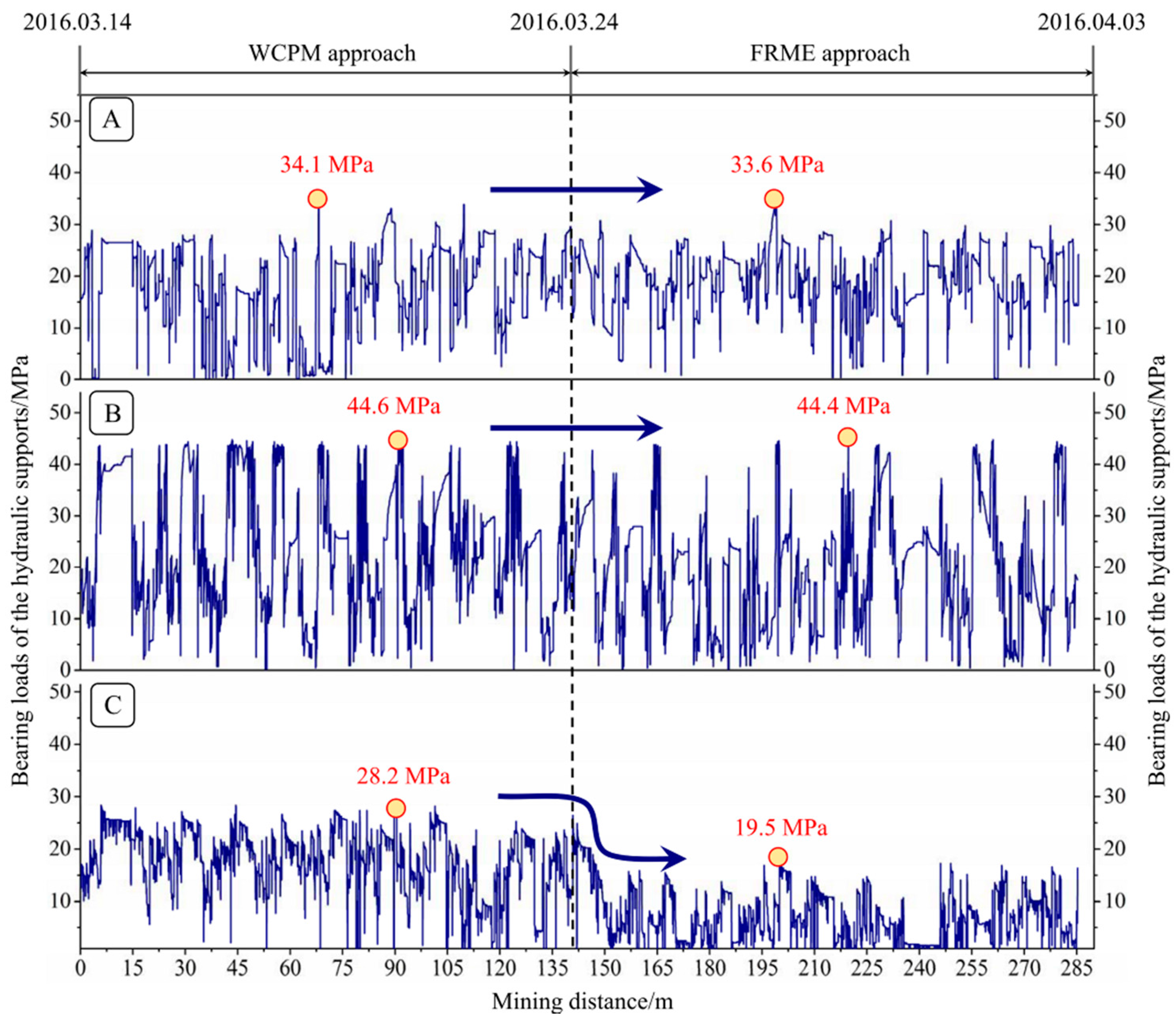
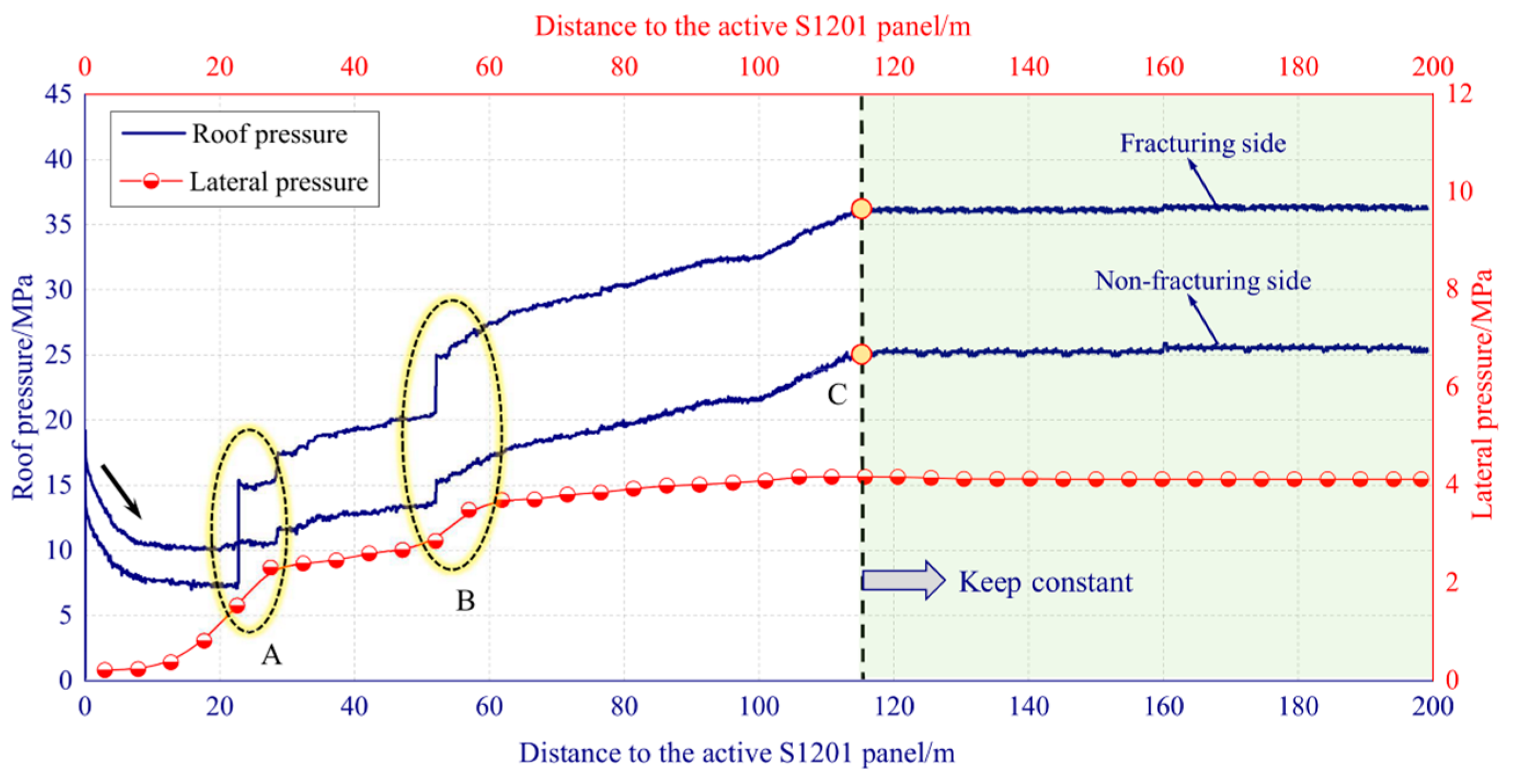
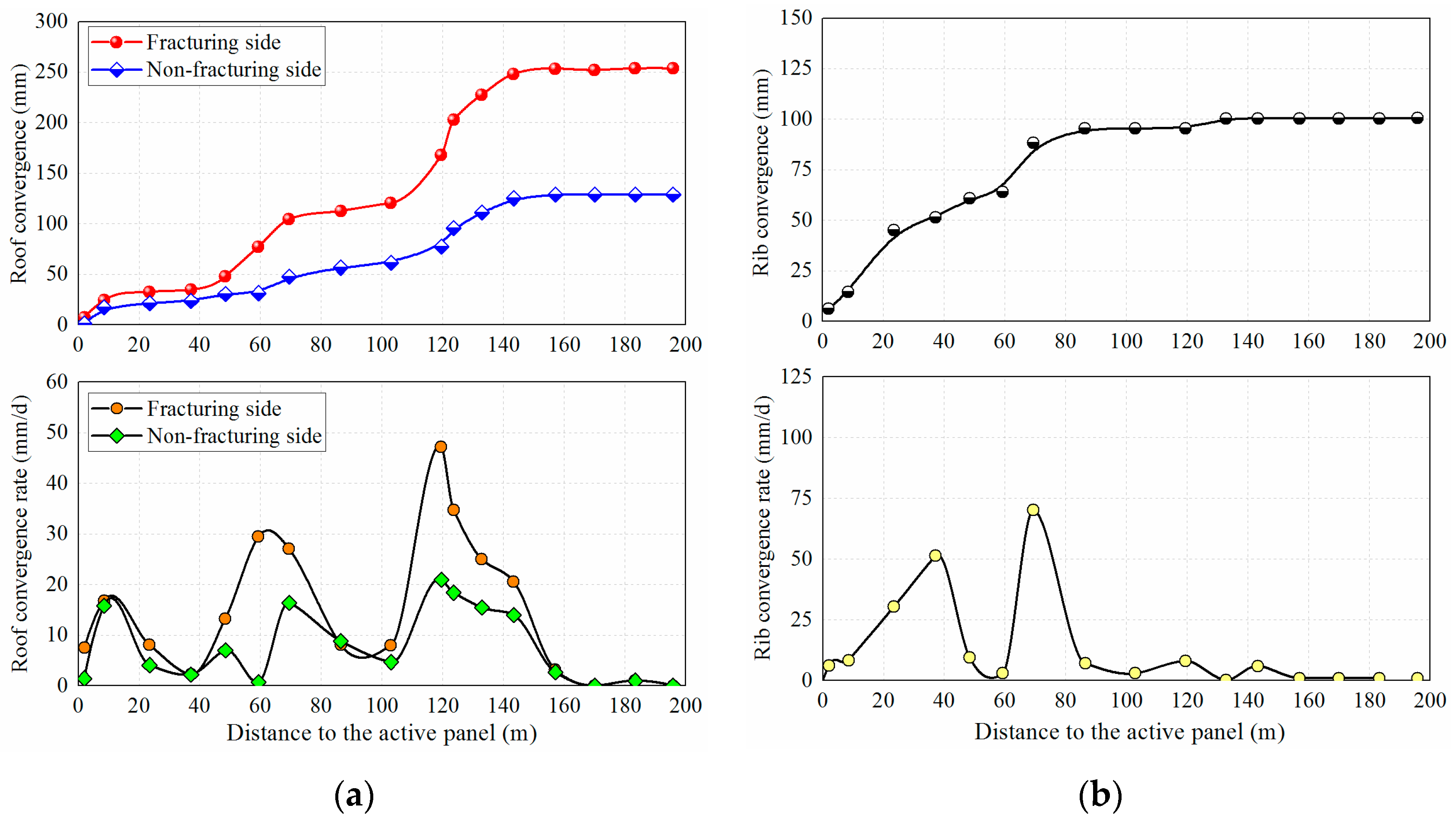

| Rock Strata | Density (kg/m3) | Uniaxial Compressive Strength (MPa) | Young’s Modulus (GPa) | Friction Angle (deg.) | Cohesion (MPa) |
|---|---|---|---|---|---|
| Medium sandstone | 2500 | 69.34 | 15.86 | 37 | 2.24 |
| Quartz sandstone | 2700 | 81.32 | 17.78 | 43 | 3.78 |
| Siltstone | 2400 | 38.65 | 14.33 | 34 | 1.87 |
| Coal | 1400 | 17.78 | 3.535 | 31 | 1.52 |
| Siltstone | 2400 | 38.65 | 14.33 | 34 | 1.87 |
| Fine sandstone | 2600 | 78.35 | 16.56 | 39 | 3.56 |
© 2017 by the authors. Licensee MDPI, Basel, Switzerland. This article is an open access article distributed under the terms and conditions of the Creative Commons Attribution (CC BY) license (http://creativecommons.org/licenses/by/4.0/).
Share and Cite
He, M.; Gao, Y.; Yang, J.; Gong, W. An Innovative Approach for Gob-Side Entry Retaining in Thick Coal Seam Longwall Mining. Energies 2017, 10, 1785. https://doi.org/10.3390/en10111785
He M, Gao Y, Yang J, Gong W. An Innovative Approach for Gob-Side Entry Retaining in Thick Coal Seam Longwall Mining. Energies. 2017; 10(11):1785. https://doi.org/10.3390/en10111785
Chicago/Turabian StyleHe, Manchao, Yubing Gao, Jun Yang, and Weili Gong. 2017. "An Innovative Approach for Gob-Side Entry Retaining in Thick Coal Seam Longwall Mining" Energies 10, no. 11: 1785. https://doi.org/10.3390/en10111785





